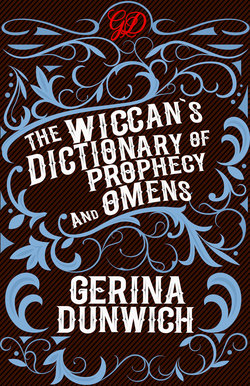Читать книгу The Wiccan's Dictionary of Prophecy and Omens - Gerina Dunwich - Страница 9
На сайте Литреса книга снята с продажи.
ОглавлениеBELOMANCY The art and practice of divination by arrows. It was extensively practiced among the Chaldeans, Babylonians, Scythians, and Arabs.
Three divining arrows marked with certain occult symbols, names, or prophetic inscriptions would be cast into a quiver, mixed together, and then one would be drawn and interpreted. In certain countries, wands or small wooden sticks were used instead of arrows. (See RHABDOMANCY.)
In the Bible, belomancy was practiced by Nebuchadrezzar (Ezek. xxi 21): “When he stood in the parting of the way … to use divination: he made his arrows bright.”
BIBLIOMANCY (also known as stichomancy) The art and practice of divination by means of opening a book at random and then interpreting in a prophetic fashion the first words or sentences read.
Just about any book can be used in the art of divination; however, grimoires and collections of poetry or prose appear to be the most popular among modern book-divining Witches.
Lots of the Saints is a Christianized form of bibliomancy, which employs the Gospels and the Holy Bible. For an answer to a specific question, or to receive symbolic messages regarding future events, open a Bible to a randomly selected page while your eyes are closed. Place the index finger of your right hand anywhere on the page, and then open your eyes. Whatever word or line your finger is pointing to can then be interpreted. (See LOTS OF THE SAINTS.)
Homeric Lots and Virgilian Lots are two ancient forms of bibliomancy involving randomly selected passages from the written works of Homer and Virgil, respectively, which are then interpreted to reveal future events or to answer a specific personal question. (See HOMERIC LOTS and VIRGILIAN LOTS.)
BLETONISM (See HYDROMANTIA.)
BOOK OF CHANGES (See I CHING.)
BOTANOMANCY The art and practice of divination by herbs or by burning branches of brier and vervain on which are inscribed specific questions to be answered. [Vervain is a plant which has long been associated with Witches, sorcerers, and the magickal arts, probably since the beginning of written history.]
The practice of botanomancy, which derives its name from the Greek word botane (meaning “herb”), can be traced back to the ancient Druid priests who believed in and worshipped the spirits of trees, particularly the oak.
The ancient Romans were also known to practice botanomancy, and their plant of choice was the laurel. They believed that by burning its leaves and then studying the ashes and/or smoke generated by it they could draw omens that would offer them guidance, warning, or a revelation of future events.
A number of references to botanomancy appear in the Old Testament. In the Second Book of Samuel (5:23–24) it is said that through the rustling of trees, David received holy information about the battle with the Philistines.
In modern times, botanomancy continues to be practiced in various ways. Two of its most simplest forms are the picking of a four-leaf clover and the blowing of seeds off the stalk of a dandelion and then making a wish.
Other methods of divination that are related to botanomancy are capnomancy, causimomancy, critomancy, cromniomancy, daphnomancy, phyllomancy, and phyllorhodomancy.
BRIZOMANCY The art and practice of divination based on the prophetic inspiration of Brizo, an ancient goddess long worshiped in Delos. She delivered oracles in dreams to men and women who consulted her regarding seafaring and the business of fishing.
In order to receive her divine protection for those engaged on the sea, the women of Delos would present her with offerings consisting of miniature boats containing various types of food, except fish.
BUMPOLOGY A nickname used by some for the art and practice of divination known as phrenology. (For more information, see PHRENOLOGY.)
